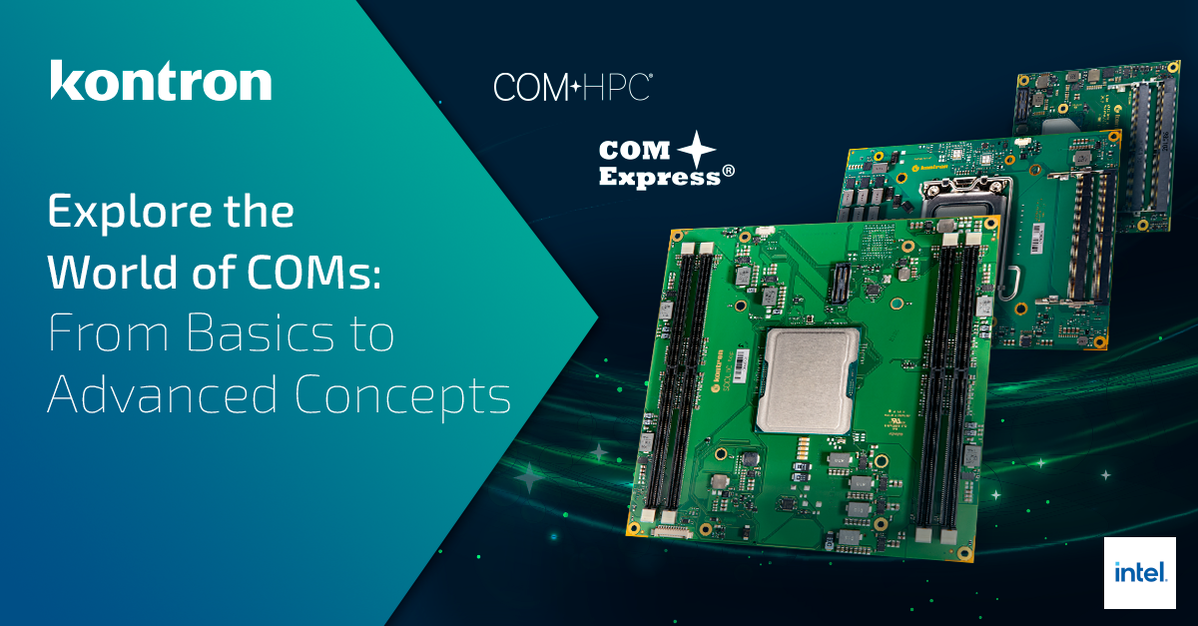Before building your next embedded application, take our bird's eye tour through the dynamic world of standardized Computer-On-Modules
Demand for Computer-on-Modules - largely known as 'COMs' - has risen dramatically over the last 20 years. This has been driven by several factors, not least the embedded computing industry's ongoing initiatives to ensure the availability of standardized modules, namely COM Express®, COM-HPC®, SMARC™ and Qseven®.
For embedded designers and developers, the main attraction and advantages of choosing industry-standard COMs are as follows:
- A faster, more flexible, and scalable approach compared to full custom COM designs
- Can be deployed as quickly as off-the-shelf motherboards and have the benefit of making future processor upgrades far easier
- Offer designers added peace of mind through transparent technology roadmaps, long-term availability of modules in specific format factor sizes, and wide-ranging accessories
- Standardized COMs stimulate healthy market competition and pricing by eliminating reliance on a single vendor
At Kontron, not only do we manufacture and sell a wide range of COM products, we also have helped evolve them from the ground up. We did this by actively participating in various design steering committees and collaborating with other vendors. For more than two decades, we've been at the heart of helping shape the original and subsequent specifications of the industry's most successful standardized COM solutions. This makes us particularly well-placed to help you become acquainted with today's dynamic COMs landscape.
Mid-range to High-end COMs:
COM Express® and COM-HPC®
Since its initial ratification in 2005 by the PCI Industrial Computer Manufacturers Group (PICMG®), of which Kontron is a founder-member, COM Express® has become one of the world's most popular embedded hardware standards. It spawned eight different Types, four different sizes, and three significant revisions while retaining a modular architecture that promotes vendor interoperability and technology reuse. Today, the standard includes the Mini (84 x 55mm), Compact (95 x 95mm), and Basic (125 x 95mm) form factors with Types 6, 7, and 10 pin-outs.
COM Express® is for use in many embedded applications requiring mid-range edge processing and networking capabilities. These include automation, defense, transportation, medical, and other technology-driven markets. Today's most popular in-use Types are 6 and 7 –and Type 10 in the mini form factor (84 x 55mm), which is well-suited to match the feature and performance requirements of ultra-small, embedded solutions.
To this day, Kontron continues to be a driving influencer of the COM Express® standard, and our engineers remain deeply involved in new developments. However, our role and influence at the PCMIG goes beyond COM Express. The COM-HPC® standard specification released in early 2021 was conceived to recognize developers requiring standardized high-performance COMs – going beyond the limits and capabilities of COM Express and other COM standards.
COM-HPC Meets Performance Demands
While complementary, it is also distinct from COM Express® by directly addressing the new demands and supporting the need for future-proofed compute, scalability, transmission, and network performance. As such, COM HPC® is quickly becoming essential in AI and higher-end 3D medical imaging and applications in the military and aerospace industries. And in industrial automation, for example, where exponential amounts of data are produced from sensors, devices, and actuators, often requiring local pre-processing at the edge. Similarly, the advent of 5G wireless will increasingly generate huge data backhaul traffic volumes and processing requirements in the communications sector. At the same time, autonomous vehicles, factory floors, and HPC workloads will demand server-class processors to support much higher-end platforms.
Low Power, Miniature COMs:
SMARC™ Modules
Introduced in 2013 by SGET (Standardization Group for Embedded Technologies), the SMARC™ (Small Mobility Architecture) module is aimed at manufacturers of carrier boards and system developers requiring SoC-based ultra-low power Computer-on-Modules in miniature format. In 2012, Kontron completed the original SMARC™ specification under the working title ULP-COM (Ultra Low Power Computer-on-Modules).
Applications are continually expanding, for example, in manufacturing automation, industrial control solutions, image processing, and multimedia. SMARC COMs have also become well-established as building blocks for very small portable handheld devices.
SMARC was born from the necessity of a COM standard that could support energy-saving ARM System on Chip (SoC) processors. Utilizing the proven Mobile PCI Express Modules (MXMs) edge connector, SMARC defined two sizes of module - a full-size module that measures 82 mm by 80 mm, and a short module for more compact systems measuring 82 mm by 50 mm. However, in contrast to the PCI Express focus of COM Express®, the SMARC pin-out provided the flexibility for handling different types of video and graphics output, serial buses, client and host forms of USB, serial and parallel camera interfaces, and support for standard flash-memory cards formats such as SD and eMMC.
Subsequently, Intel improved the power efficiency of its processors with Atom-based SoCs, allowing x86 architecture products to also benefit from the SMARC™ format. At the same time, The Internet of Things (IoT) was becoming a hugely significant disruptor, bringing previously unforeseen opportunities and challenges for vendors seeking to connect numerous devices with different technological requirements.
These developments created a twofold requirement that became the catalyst for SMARC 2.0, introduced in 2016: To accommodate universal IoT connectivity while also bridging the gap between the specific interface requirements of ARM and Intel processors. Essentially, the SMARC 2.0 specification provided an enhanced pin-out to better accommodate customer needs and processor interfaces while perfectly matching the original standard for these low-profile form factor modules.
2020 saw the introduction of the SMARC 2.1 module specification – more here - the third and current iteration.
In a nutshell, Kontron's ability to innovate as an international technology leader and as a 'standardiser' of industry-leading Computer-on-Modules is matched by extensive support along with notably long-term product availability. This ensures that customers and partners benefit from the high level of investment security available.
Find out more about Kontron COMs here.



{{comment.comment}}